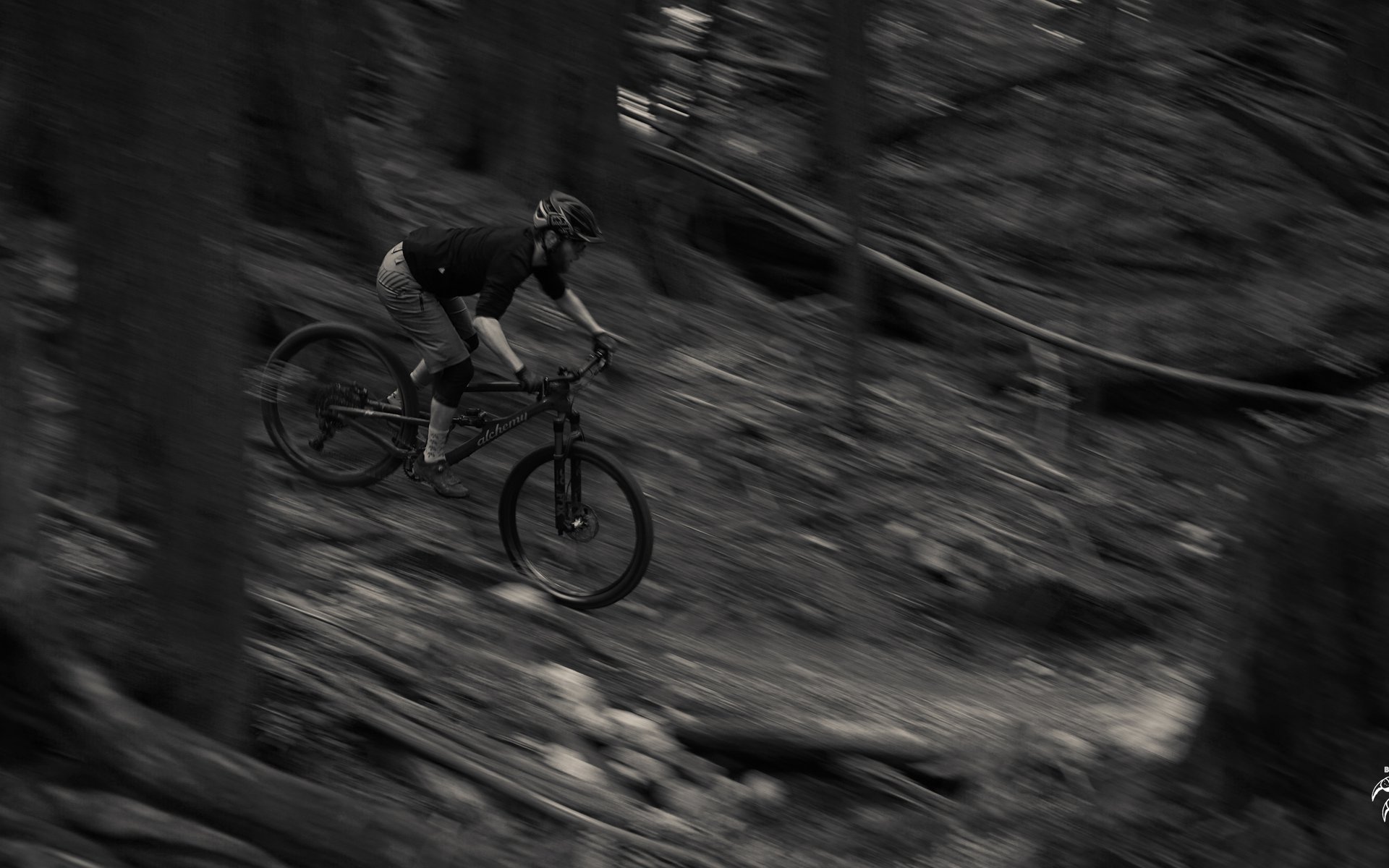
REVIEW
Alchemy Arktos 29 - Reviewed
There’s a lot to be said for first impressions; its one of the reasons I try to avoid looking at geometry numbers, kinematics, or any kind of real info that might give me pre-conceived notions until I’ve got some time on a new review bike. First thoughts on the Alchemy Arktos 29er as it came out of a box?
“Whelp. It's definitely pretty.”
Lets dive in.
The Parts that say Alchemy
From a distance, I’m a fan the organic design elements here; I think its almost a shame if designers don’t take advantage of a material like carbon to add some curves and shapes. Alchemy was making these frames in-house, however they’ve been successful enough to move manufacturing overseas.
Its also visually apparent this bike isn’t particularly long, low, or slack as is the rage these days but is certainly a well proportioned bike. Zooming in, the paint and finish are excellent; there are some other muted colorways on option, and they have a full service custom paint shop available for a charge if you simply have to have your frame match your Burnt Orange Tacoma. All cables/hoses are routed internally, through rather tiny ports (I did not change any cables or hoses on this bike, so don’t have direct experience, but these look challenging. I much prefer some kind of door to open for ease of access, or tubes-in-tubes).
There’s a small integrated top-mount chainguide just above a threaded (!) bottom bracket, and Alchemy has also jumped on the 157mm rear end train, so if Super Boost is a non-starter for you, look elsewhere. Of great importance to many people who aren’t me, it does not fit a waterbottle inside the front triangle; there are some mounts below the downtube surrounded by a nice rubber frame protector. Unfortunately, this protector doesn’t go high enough to cover potential tailgate/shuttle damage.

Geometry across the range - these numbers aren't progressive, but they're solid. Given the Seat Tube Length on my size large, I'm not sure I could have run a longer drop post (at least without switching brands).
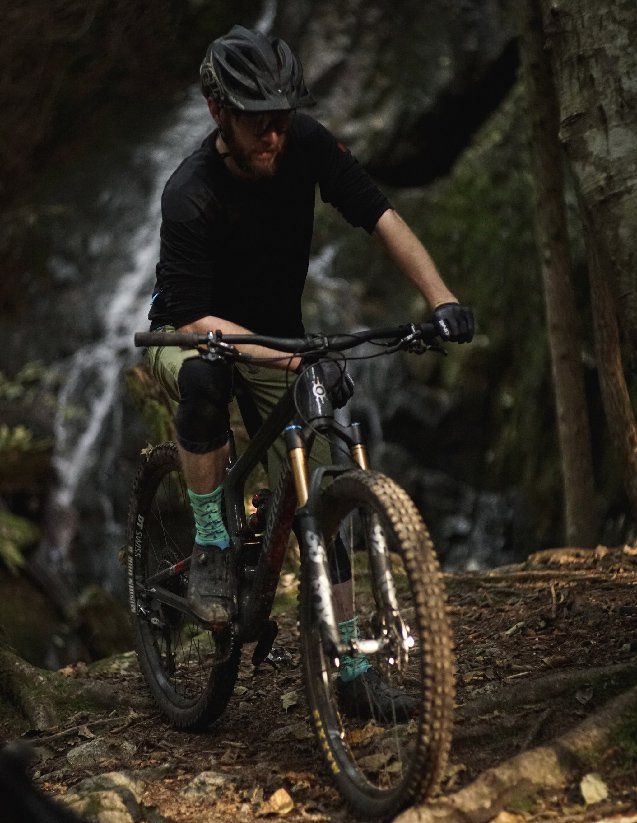
"Is it just me, or are these handlebars really far off the ground?" I’m 5’10”ish, with a 30” inseam, and 169lbs before I put anything on over my chamois.
After a thorough bolt check, I threw it on a scale (30lbs, 6oz without pedals) set suspension pressures and knobs to some baseline guesstimates from Alchemy, squished some PSI into already-tubeless tires, slapped some pedals on and off we went to get acquainted.
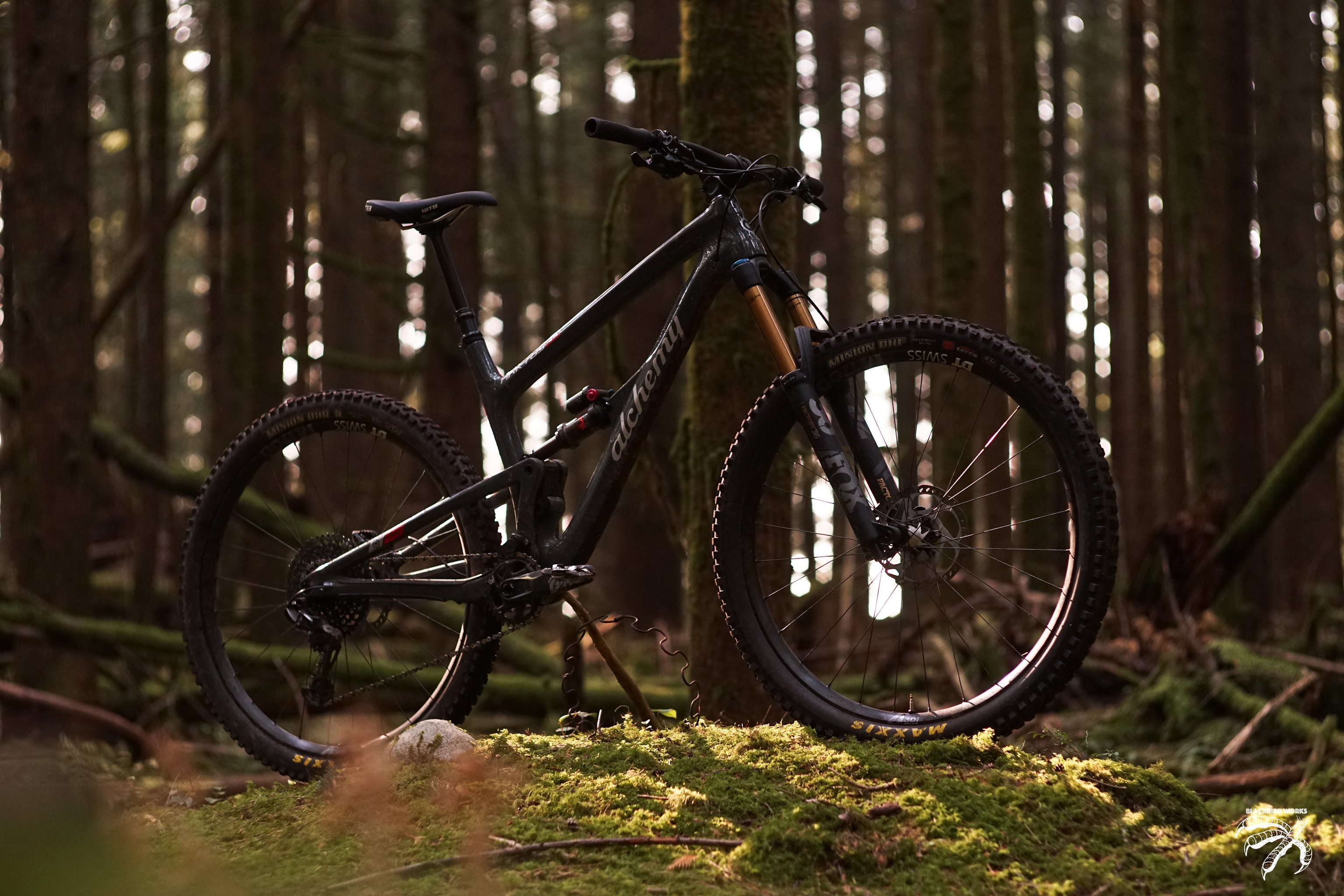
Remember when I said its pretty? Its got lovely swoops, and curves in all the right places.
Bits that don’t say Alchemy on ‘em
With a few exceptions we’ll discuss later, the parts spec is a well executed mix of value and performance; high end suspension, good-but-not-bling drivetrain/brakes/wheels, with some value thrown in in places users might want to swap parts anyway. As Uncle Dave likes to point out, this isn’t a Cam Spec build, at US$4,899, its on the lower end of “high performance” bikes (and probably more interesting that way; if a bike is US$10k all the parts on it better be f*&ing good!). In a nice touch, all builds come with high end suspension. The bike rolls on DT Swiss M1700 wheels. While I don’t love centerlock, or straight pull, they’re a decent spec choice at this price level offering reasonable engagement, reasonable weight, with a nice 30mm internal width that gives a nice profile to the Maxxis DH-F/DH-R combo. I managed to put a few sizeable dents in the rear rim in fairly short order.
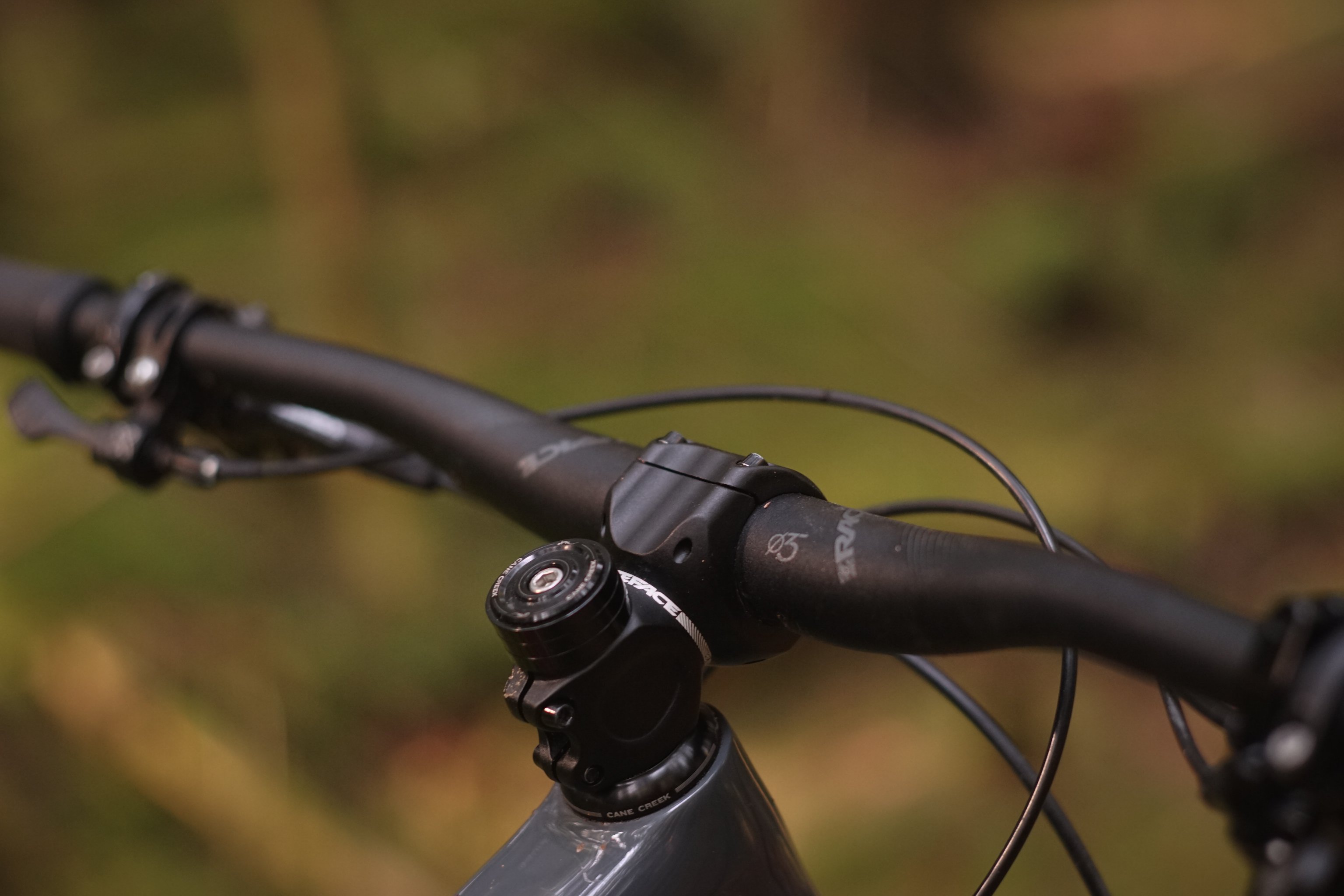
Cockpit spec favors function and modesty over bling factor. Stem slammed.
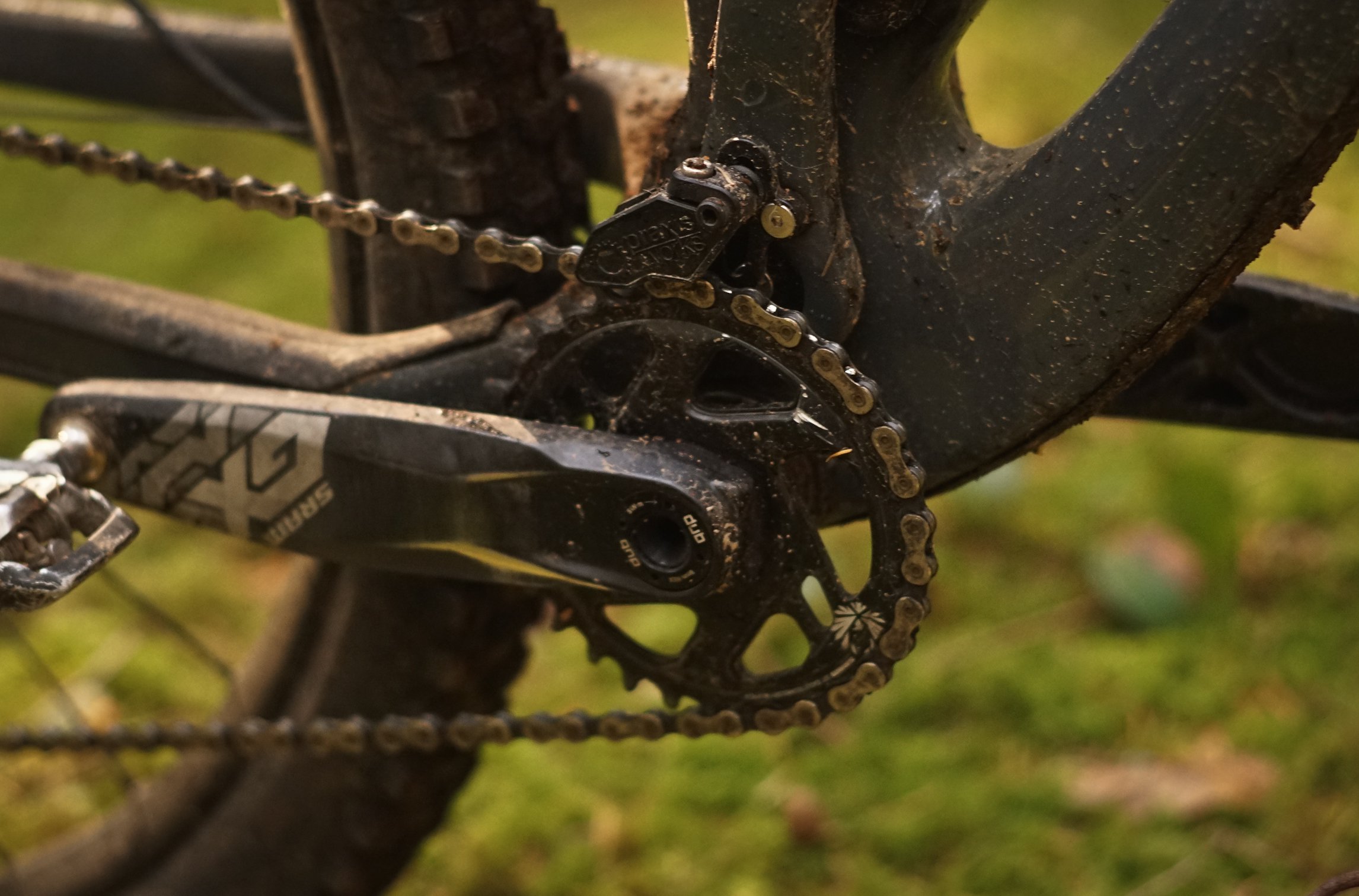
The integrated Praxis top mount guide is a nicely executed feature. Downtube, chainstay, and seatstay protection are all a thick, durable rubber. There were minor adhesion issues on the chainstay - I find this is very common in the wet conditions of the Shore.
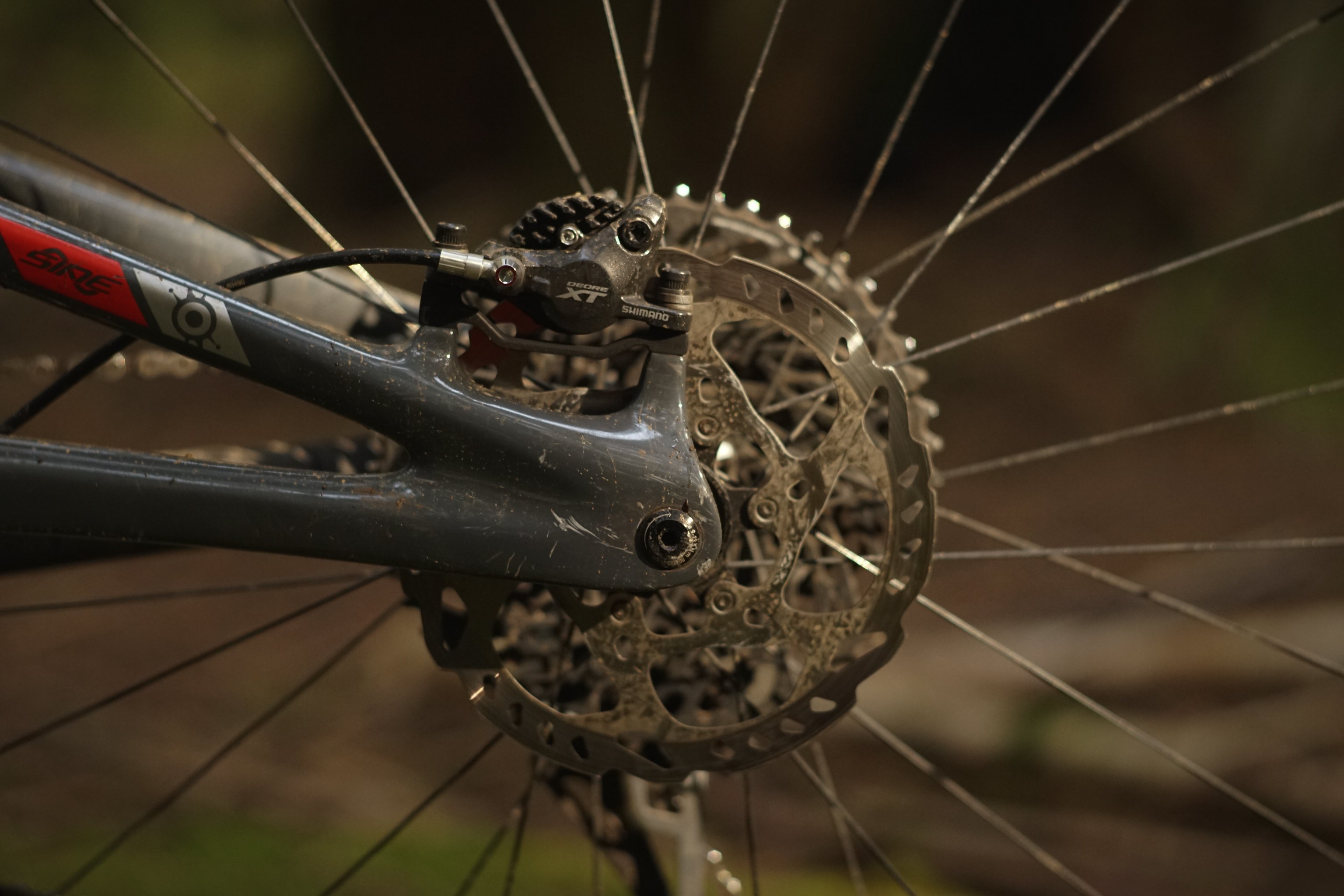
Shimano XT M8000 brakes oppose a SRAM GX Eagle drivetrain; both excellent spec choices that again favor function and cost over bling.
The air spring’s connected to the…
This is a David Earle-designed, dual-link suspension. Up until the new more industrial looking SB130 and SB150, it would have been relatively easy to mistake this bike for a Yeti with a paintjob from a distance. And you wouldn’t be far off base; David was the designer behind Switch suspension (precursor to Switch Infinity), and also penned Alchemy’s “Sine” patented suspension design. Its quite similar in function as well. Instead of the purely vertical motion along the Switch Infinity's stanchions, or the small rotating cam of Switch, Sine has very short lower link that rotates basically inside the frame, which gives the desired kinematics and leverage ratios through the bike's travel. Sine refers to the rate curve; an initial falling rate transitions to rising rate through the midstroke, followed by a falling rate to offset air spring’s natural ramp up at the end stroke.
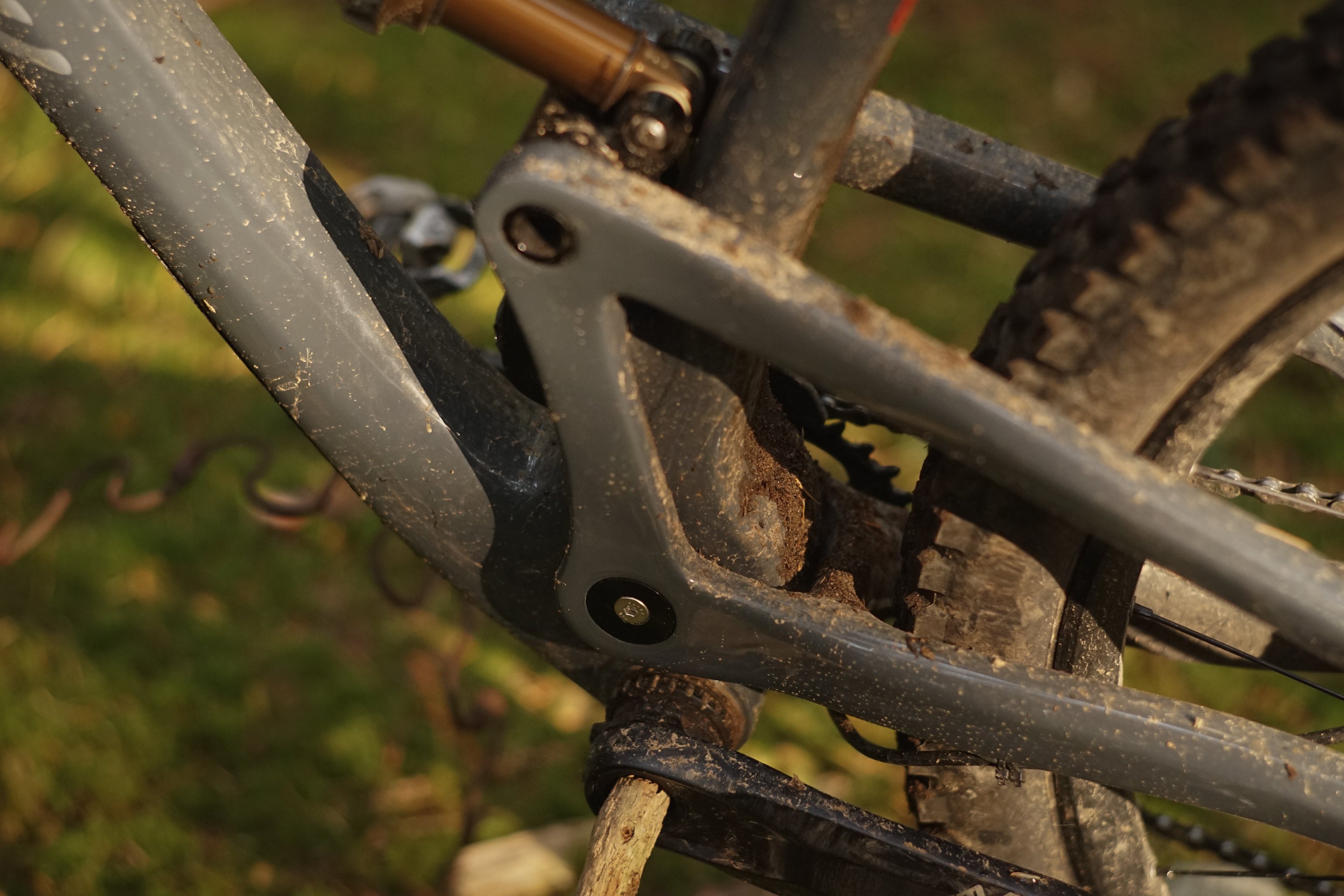
A teensy link rotates in the bottom of the seattube, above the BB as the lower link in the dual link system. I had no issues with bearing or link wear, and I prefer the more enclosed design over Switch Infinity. If you'd like to see it go up and down, click here.
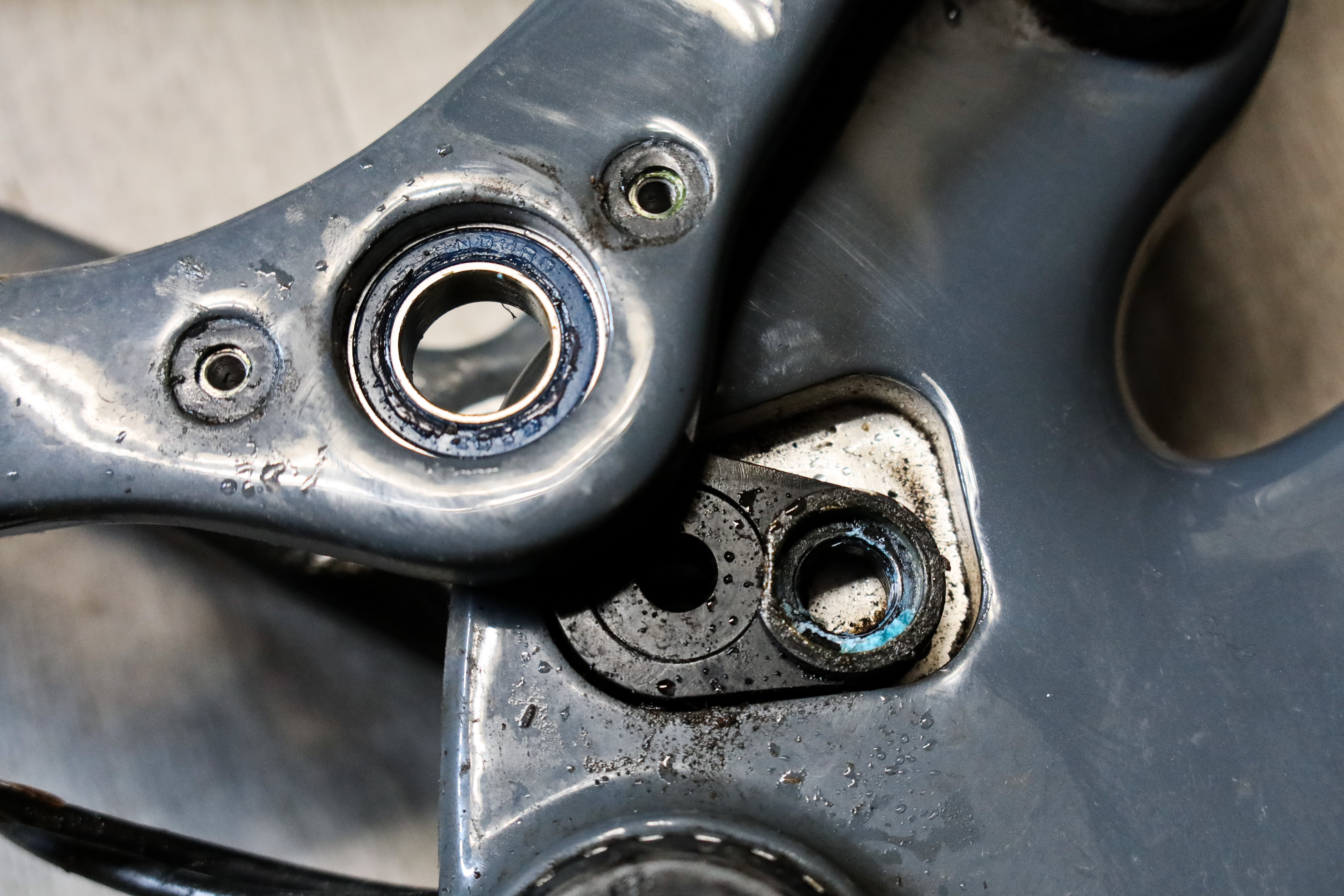
The aforementioned teensy link, notably and unsurprisingly located in a similar spot to Yeti's Switch Infinity stanchions, and very similar in function to the original Switch. (Photo: Cooper Quinn)
When rubber meets dirt (and wet roots)
Component-wise, I had two issues right out of the gate, but they’re somewhat personal, and weather related. The DH-F/DH-R combo is great and would have been my preferred choice for sopping wet North Shore root gardens, however the Dual Compound versions selected provide what can only be described as an impressively low coefficient of friction in the presence of moisture. The same can be said about the Egron grips; I found them hard, they transmitted far to much noise to my hands, and lacked any discernible friction in the wet. Did I mention I have permanently sweaty hands, and live somewhere it rains a lot? Swapping the front tire and grips out was a high priority, but I don’t begrudge Alchemy here. Contact points are a personal choice, and in most places that aren’t exactly the conditions I often ride in, the tires are great all-rounders.
The SRAM GX Eagle shifting has been as expected; a budget-oriented yet solid choice that I have few complaints about. The Shimano XT M8000 brakes have the patented Wandering Bite Point; they’re also the most powerful, fade free set of XT’s I’ve ever been on. (note - this bike would now ship with the new XT 8120 brakes - Ed.) The only other component that doesn’t already have encyclopedic levels of review is the X-Fusion dropper lever. Despite my initial misgivings about it feeling a bit cheap, it performs well with good leverage and throw, and the lever’s adjustability is worthwhile.
Stack height was the most apparent geometry number initially; the Arktos is a full 23mm (an inch!) taller than my current Rocky Mountain Instinct BC, and who-even-knows how much taller than my Sick GrimRipper (Honestly, I have no idea what the geo on that frame is. Sick was a constantly moving target. Its certainly low and slack, though.) With the stem slammed I started to get comfortable and acquainted with a pretty well rounded... mountain bike? With “only” 140mm on tap in the rear, and geometry not focused on being an exceptionally aggressive descender I’d struggle to label this a modern ‘enduro’ bike, but it’s probably got too much travel - especially up front at 160mm - to be a true ‘trail’ bike. So a mountain bike it is, then. And so we shall test it as a mountain bike, a quiver of one; XC epics to enduro racing to full face shuttle days.
Going Up
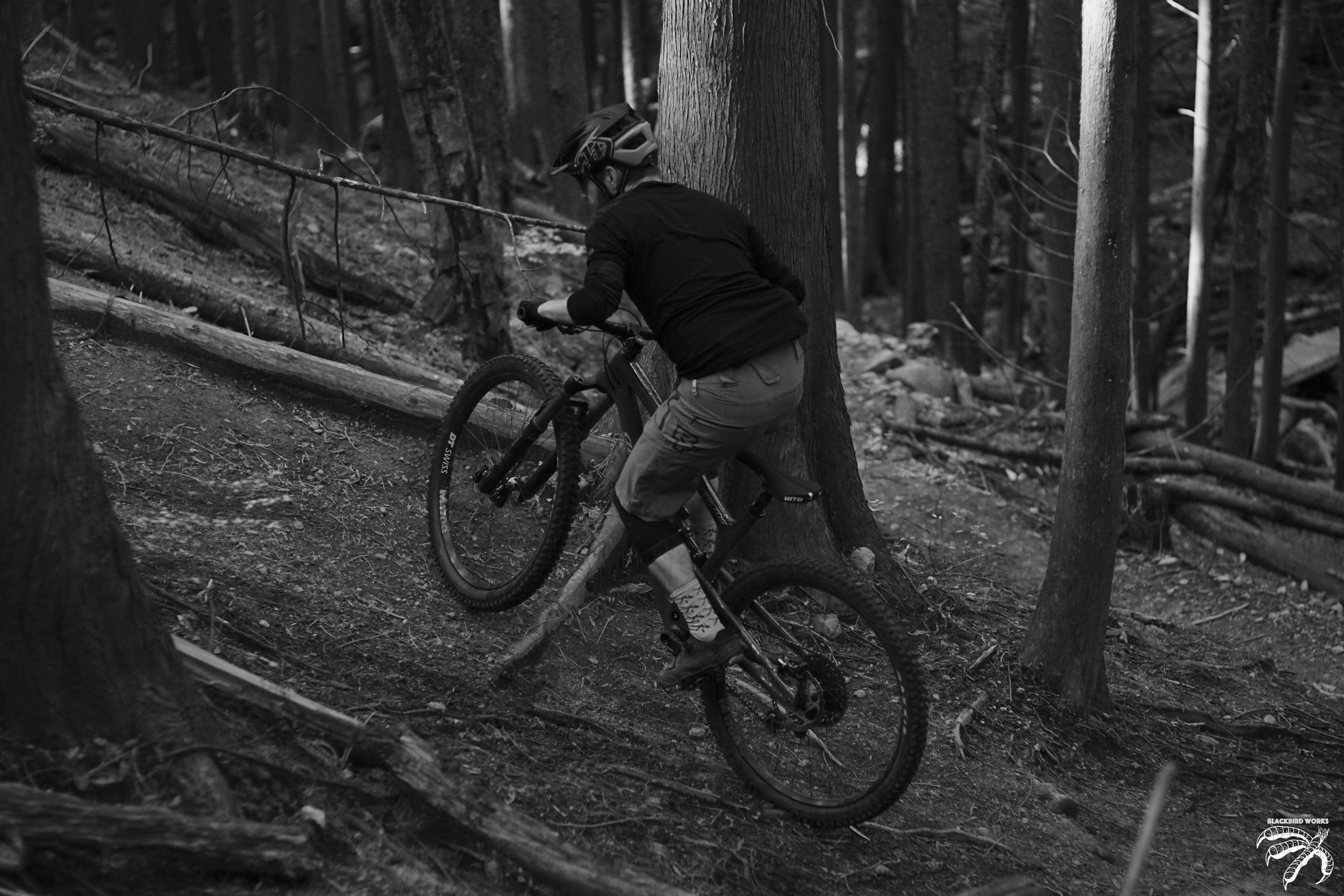
Steep climbing on the Arktos requires big body positioning moves to keep the front wheel down, and you may still get some front end wander like I'm experiencing here.
As you’d hope and expect from modern suspension, the Arktos climbs well. Its not going to win any pure efficiency records, but it does a great job of trading a couple of watts for traction, especially when the going gets rough. That said, its not a bike that you're likely to use a climb switch for off-road. This slight efficiency compromise, coupled with good mid-stroke support means you can pedal in places you might struggle on other platforms - this bike excels at ripping around with chunky ground on undulating moderate grades, maintaining momentum throughout. When the going gets super steep, the slack-ish steat tube angle, stack height, and short-ish chainstays all conspire to make the front end very light with a propensity to wander. The Sine Suspension will provide ample traction to winch yourself up anything, but prepare to get up on the rivet, bend your elbows, and really chew on your stem.
Going Down
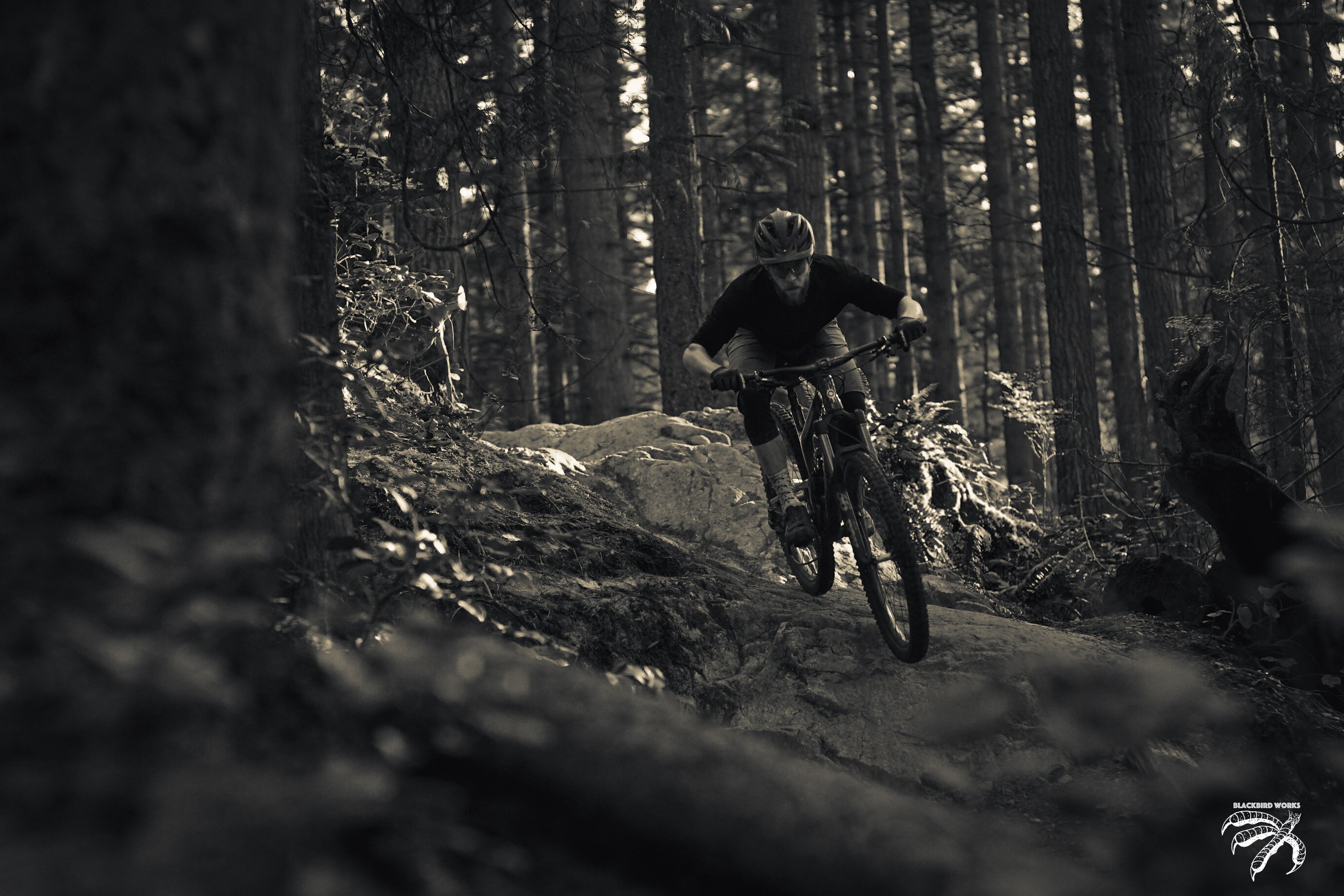
The fun direction.
The Arktos is a bike you are “on” not “in.” The kinematics and geometry mean its quite nimble and playful, wanting to take you to those little side hits and pops. Its not a bruiser or a plow, and it isn’t built for outright speed (Cody Kelley is good evidence that this bike is perfectly capable of going fast in the right hands, mind you). It’ll carry you down ‘the gnar,’ should you so choose, however I managed to meet or exceed my personal comfort limits on this bike on a few moves I’m confident riding on other machines. Feeling a bit of chassis flex wasn’t uncommon, but on the Arktos its not unnerving or distracting, it feels well engineered. An annoying niggle - cables and hoses rattling around in the downtube make a bit of a racket.
The Arktos rewards good body positioning, and tossed me to the ground on two occasions when I forgot the front end needs weight during cornering. This isn’t a fault, but there’s perhaps less leeway than other bikes may allow. I tested with a couple of different stem lengths, and found that using a stem at least 50mm long helped add a bit of weight on the front end. Overall, its a capable descender but isn’t a full scale enduro smasher; its a great mountain bike.
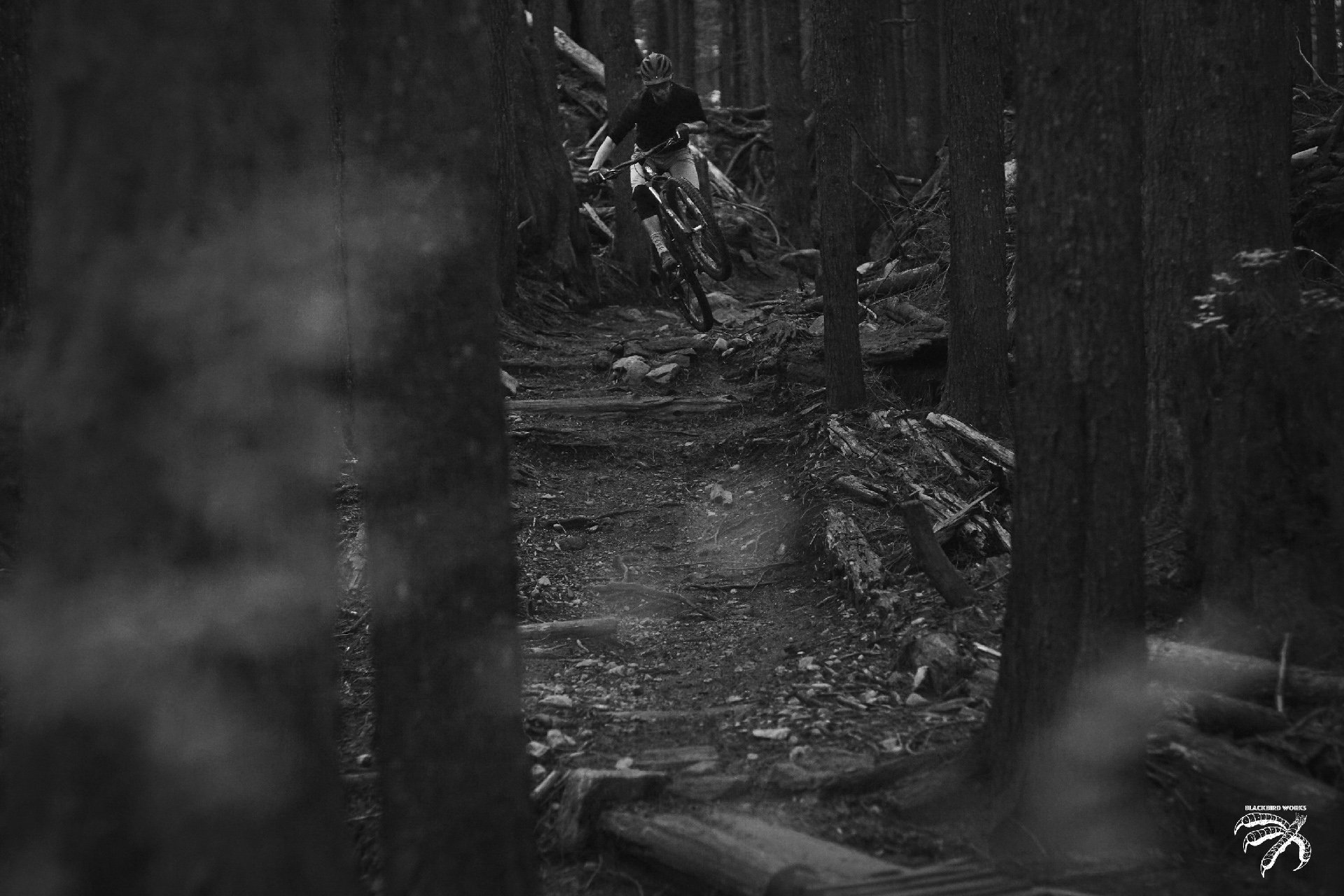
Playful is the name of the game on the Arktos 29.

Does it do skids? Yes. Definitely.
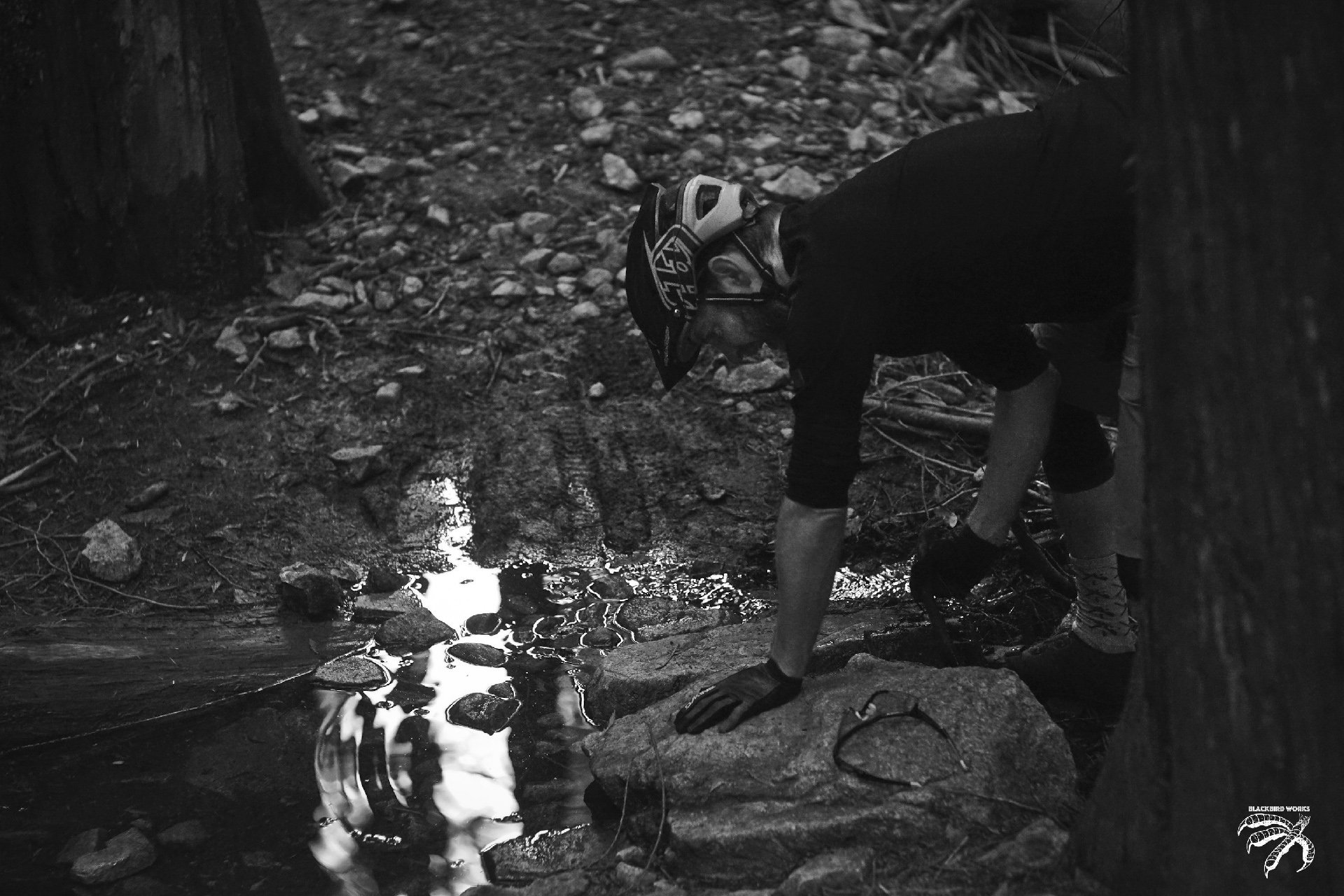
I get distracted sometimes. #draintherain
Is This the Bike for You?
The Alchemy Arktos 29 is a great mountain bike; while it doesn’t outright win at anything it's quite good at covering vast distances and vert over 8 hours, is definitely capable on bike park jumps, and will handle shuttle laps on the steeps. While talking to a coupe of folks about this, a common phrase emerged, “Oh, so its a Colorado bike!” Yep, totally.
I’m not sure I’d buy one living here in the Sea to Sky corridor due to the difficulty of trails I spend most of my time on, and common climbing grades. Most places on earth you’re going to be quite satisfied on this machine, and with a medium-sized budget to purchase it's a great platform to throw a few customized tweaks at to suit your riding and location. I’d also take a look at the ST (Short Travel) version of this bike if you’re going to be light on gnar and bike park days; it's a bike that’s likely to have a bit more zest for each pedal stroke, but similar geometry that’s built for fun.
For more on Alchemy, and the Arktos in particular, click here...
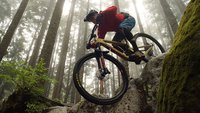

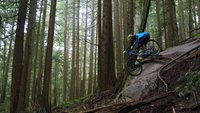
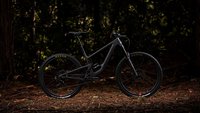







Comments
Timer
4 years, 2 months ago
Thank you for the in depth review. On paper, the seat tube seems very long, limiting dropper extension. What was your experience with that?
I think that the Arktos ST is actually the more interesting bike. The normal Arktos seems like a hard sell among all the excellent bikes in its bracket (Occam, Reactor, Jeffsy, Genius, Prime, Ripmo,....). But an even more nimble short travel version has a lot of appeal. Plus, shorter droppers won't be that much of an issue on shorter travel bikes.
Reply
Cooper Quinn
4 years, 2 months ago
The test bike was a large - I'm 'round about 5'10-ish and with a relatively short 30" inseam. I've got 1" of additional drop I could use on the post. If I wanted to use something with more drop, I might have to look at a post with less stack height.
So... your concerns aren't unfounded, but a lot of riders my height will probably have a little bit more wiggle room.
And agreed - this bike is in a very crowded market. The ST platform is very interesting, if possibly a bit less of a One Bike to Rule Them All here in BC? It'd be a lot more interesting to me if the geo was modernized a bit, I really enjoy a good short travel bike (I'd love to play on a Yeti SB100 for a bit). The suspension works well, but the angles on this (or the ST) just never quite did it for me around here when the going got steep.
Reply
Mike
4 years, 2 months ago
I'm a little surprised you found the STA to be that slack - I have to imagine this bike fares far better than the recent crop of Santa Cruz bikes with their extremely slack actual STAs. At least the Arktos has a similar actual vs effective STA.
Reply
Cooper Quinn
4 years, 2 months ago
The STA in isolation isn't that slack - I don't think I framed that as a real problem here? Slack-ish.And worth noting I'm not particularly prone to the challenges of people with large inseams and slack actual STA's.
But you can't look at any geometry number in isolation; take a somewhat slack STA, add some stack height, relatively short reach, and your center of mass is positioned rather near the rear axle when things get particularly steep. The new Hightower is a full 20-something mm longer in reach, and has 25mm less stack height.
Reply
cyclotoine
4 years, 2 months ago
Alchemy is reporting an unchanging effective seat tube angle across the board which means you can't read much into it. If you look at the effective top tube relative to the reach you know that effectively it's slacker than 75 on the larger sizes. I'm not a bit surprised this bike suffers from front wheel wander on the steep climbs. Also, what Cooper said regarding stack and reach, +1.
Reply
Cooper Quinn
4 years, 2 months ago
Stack, reach, rear center... they're all very much at play... along with every other number in the geo chart.
Its really easy to get sucked into looking at one number... Remember when we measured bikes by seat tube? Or when nothing mattered but HTA, or BB height, or the more recent obsession with reach?
One measurement just isn't how bikes work, though. And on any bike with suspension, all the geometry numbers are dynamic.
Reply
Luke Kozakiewicz
4 years, 2 months ago
This comment has been removed.
Cr4w
4 years, 2 months ago
It's cool that not every brand Is jumping on the longer/lower/slacker thing.
Reply
Cooper Quinn
4 years, 2 months ago
Horses for courses, right?
Reply
Cr4w
4 years, 2 months ago
Reply
Cooper Quinn
4 years, 2 months ago
This comment has been removed.
hongeorge
4 years, 2 months ago
The amount of dirt that seems to be inside and around the bearings in that second "little link" photo would worry me. I don't like the look of that at all.
Reply
Cooper Quinn
4 years, 2 months ago
I didn't have any issues, but also didn't like... smash the thing through a full Shore winter. Its also not that hard to take apart to clean, but I'd agree with your assessment that its sub-optimal.
Reply
Lma
4 years, 2 months ago
> Alchemy was making these frames in-house, however they’ve been successful enough to move manufacturing overseas.
That's an interesting bit of spin!
Reply
Please log in to leave a comment.